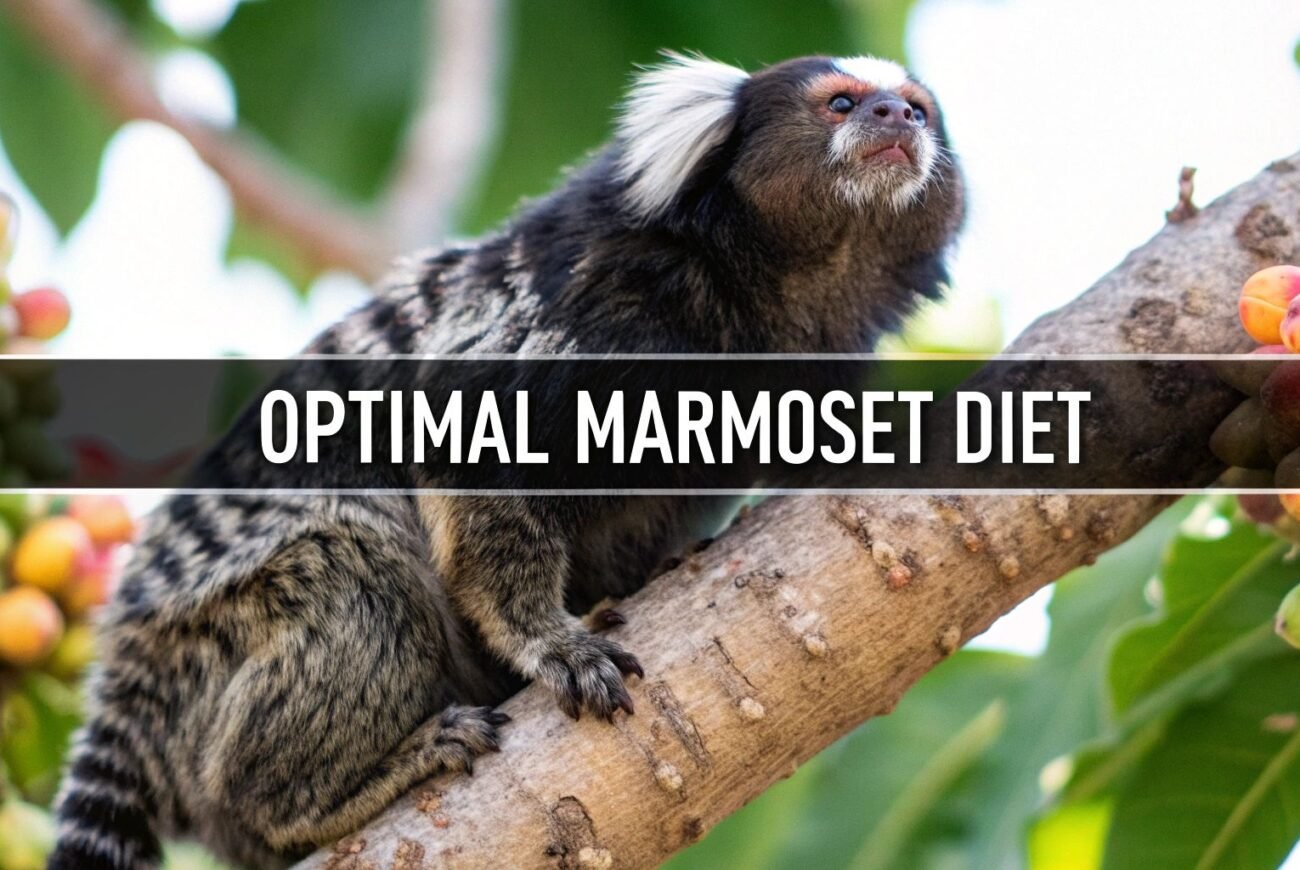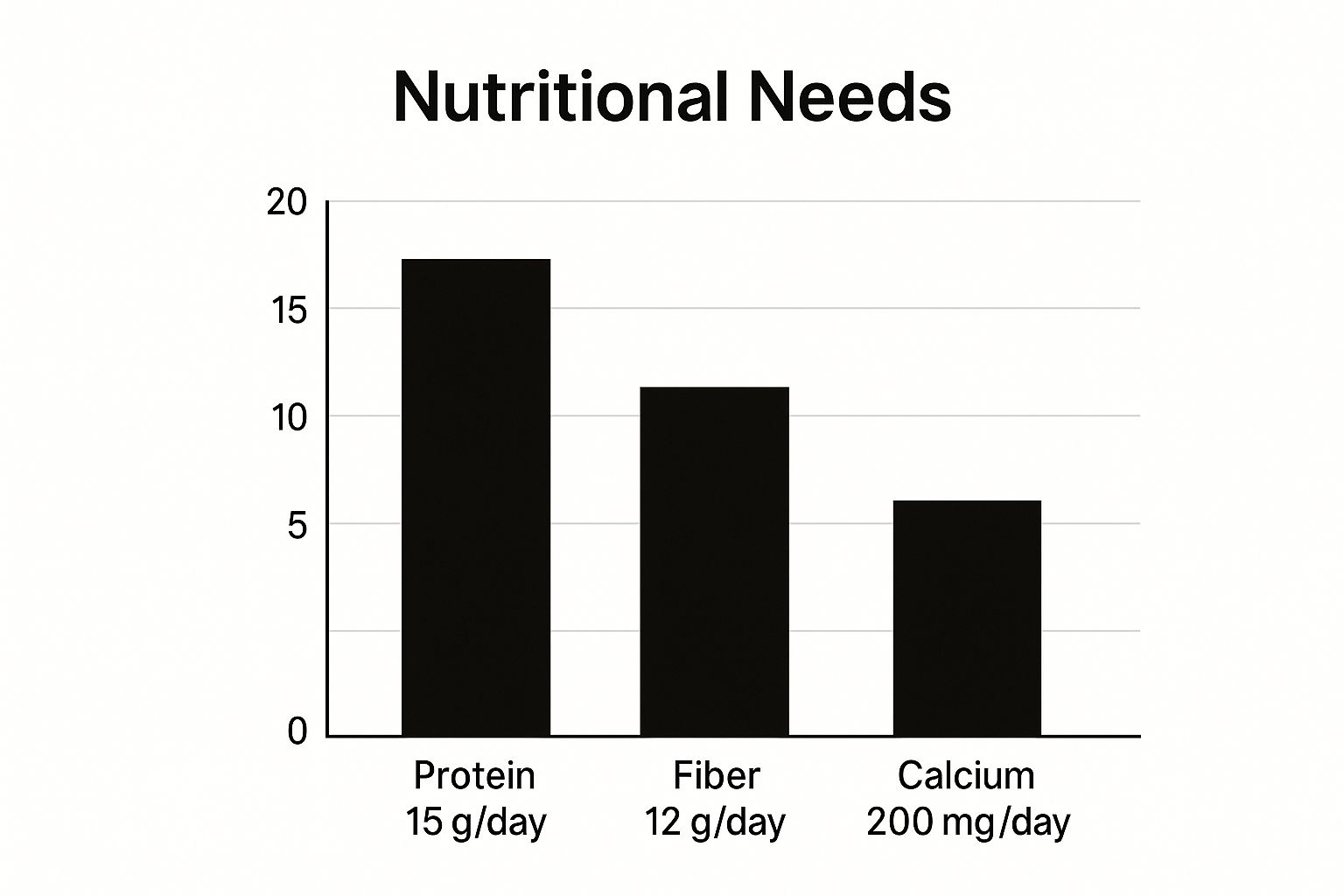
Marmoset Diet Tips for Optimal Care & Health
Wild Vs. Captive Marmoset Diet: Bridging the Gap
In the wild, a marmoset's diet is a diverse and complex affair, a true "nutritional symphony" orchestrated by nature itself. These small primates, native to the rainforests, have evolved specialized digestive systems perfectly suited to extracting nutrients from a wide variety of foods. This foraging behavior, the active search for sustenance, is integral to their overall health and well-being. Replicating this intricate balance in a captive setting, however, presents unique challenges for marmoset owners.
The Wild Marmoset's Table: A Nutritional Symphony
Wild marmosets thrive on a fascinating mix of tree exudates (gums and saps), insects, fruits, nectar, and various plant materials. These exudates, often lacking in captive diets, are a cornerstone of wild marmoset nutrition. Their digestive systems are specifically adapted to process these complex carbohydrates, deriving essential energy and vital nutrients. For instance, some gums contain prebiotic fibers that nourish beneficial gut bacteria, which are crucial for digestion and immune function.
Captivity's Challenges: Nutritional Gaps and Health Risks
Captive marmoset diets often struggle to mirror this natural diversity. Many commercially available marmoset foods prioritize convenience, potentially overlooking the full spectrum of nutrients found in the wild. This nutritional gap can contribute to various health problems. A key difference lies in the lack of natural foraging opportunities in captivity. In their natural habitat, marmosets spend a considerable portion of their day foraging, a behavior that stimulates both mind and body. Simply providing food in a bowl can lead to boredom, obesity, and other health concerns.
Bridging the Nutritional Divide: Replicating Nature's Blueprint
Thankfully, by understanding the intricacies of the wild marmoset diet, we can significantly improve the health and well-being of captive marmosets. By incorporating a broader range of foods and encouraging natural foraging behaviors, we can bridge this nutritional divide.
- Offer Tree Exudates: While not commonly found in pet stores, specialized suppliers offer marmoset-safe gum and sap products to enrich their diet.
- Encourage Foraging: Introduce puzzle feeders and scatter food around the enclosure to stimulate their natural foraging instincts. This promotes physical activity and mental engagement, combating boredom and supporting healthy weight management.
- Vary Food Sources: Offer a diverse selection of fruits, vegetables, and insects suitable for marmosets. This variety ensures a balanced intake of vitamins and minerals, mirroring their natural dietary habits.
- Seasonal Adjustments: Just as wild marmoset diets change with the seasons, consider adjusting your captive marmoset's diet to reflect these natural variations. For example, increase the proportion of fruits during times when fruits would be abundant in the wild.
By thoughtfully considering the nutritional needs of wild marmosets and adapting their captive environment, we can ensure these intelligent and engaging primates thrive under our care. The key is to go beyond simply providing food and create a dynamic, enriching feeding experience that replicates the complexities of their natural habitat. This proactive approach is vital for preventing diet-related illnesses and ensuring a long, healthy life for your marmoset companion.
Essential Nutrients: The Foundation of Marmoset Health

Keeping a marmoset healthy isn't simply about providing food. It's about understanding the specific nutrients they need to thrive. These needs change throughout their life, from the rapid development of their younger years to the challenges of reproduction and the later stages of life. A balanced diet is key to preventing metabolic disorders and supporting a strong immune system.
Protein Power: Building Blocks for a Thriving Marmoset
Protein is fundamental to a marmoset's health. It's not just the amount of protein, but the specific amino acid profile that's important. These amino acids are the building blocks of protein, and much like constructing a building, a marmoset needs the right combination of these building blocks for healthy growth and bodily functions.
Carbohydrates, Fats, Vitamins, and Minerals: The Supporting Cast
In addition to protein, carbohydrates offer quick energy, while fats support hormone production and healthy cells. Vitamins and minerals play a crucial role in regulating bodily functions, impacting everything from bone strength to nerve function. Deficiencies in any of these areas can have a ripple effect, negatively impacting the marmoset's overall well-being.
The Importance of Vitamin D3, Calcium, and Specialized Protein Sources
Some nutrients are especially important for marmosets. Vitamin D3 is essential for calcium absorption and bone health. Unlike humans, marmosets can't efficiently synthesize Vitamin D3 from sunlight, so it must be a part of their diet. Calcium, of course, is vital for strong bones and teeth. You might find this resource helpful: How to master primate care. Specialized protein sources, similar to the insects and small vertebrates they eat in the wild, are also crucial for providing a full spectrum of essential amino acids.
Recognizing and Preventing Dietary Deficiencies
Knowing the signs of nutritional deficiencies is crucial for proactive care. Reduced activity, changes in coat appearance, and even shifts in social behavior can indicate dietary issues. Captive marmosets face unique dietary challenges, especially regarding obesity and metabolic problems. Studies show that 46% to 52% of sub-adult marmosets (aged 1-2 years) at the Southwest National Primate Research Center exhibit obesity. This is often linked to reduced insulin sensitivity, which can lead to health issues like diabetes and cardiovascular disease. You can delve deeper into this research here. Comparing wild and captive diets highlights the need for supplements. For those interested in exploring supplemental options, resources like this article on CBD for pets may be of interest. By recognizing these signs early and adjusting their diet, we can often prevent serious health issues. Creating a diet that caters to individual preferences while meeting these essential nutritional needs is the best way to ensure a long, healthy, and vibrant life for your marmoset companion.
Preventing Diet-Related Diseases in Your Marmoset
Maintaining the right diet for your marmoset is essential for preventing a variety of health issues. Unfortunately, many marmosets in captivity develop conditions directly related to their diet, and these problems often appear before owners even notice the symptoms. Understanding the connection between diet and disease is key to a long, healthy life for your tiny primate companion.
Recognizing the Subtle Signs of Nutritional Imbalances
Changes in your marmoset's behavior can be early warning signs of nutritional imbalances. For example, a decrease in activity might indicate a lack of essential nutrients. Shifts in grooming habits, vocalizations, and even how they interact socially can also be subtle hints that their diet needs attention. By carefully observing these behavioral nuances, you can identify and address potential problems before they become serious health concerns.
The Metabolic Mechanisms Behind Common Diseases
Understanding the metabolic processes at play in common marmoset diseases is crucial. Hepatic lipidosis, a severe liver disease, is often linked to a high-fat diet. Insulin resistance, which can lead to diabetes, can also be caused by a diet high in sugar or low in necessary nutrients. These metabolic disruptions can have a ripple effect on overall health, impacting organ function and making chronic diseases more likely.

This infographic shows the average daily nutritional needs of a marmoset, emphasizing the importance of balanced protein, fiber, and calcium. These small primates require about 15 grams of protein, 12 grams of fiber, and 200 milligrams of calcium every day. Meeting these nutritional needs is fundamental to their well-being. See also: How to master primate care.
Practical Intervention Strategies and the Power of Proactive Management
Thankfully, many diet-related diseases in marmosets can be reversed with the right interventions. This includes adjusting their diet to correct any deficiencies and encouraging natural foraging behaviors. Using puzzle feeders, for instance, can make mealtimes more stimulating and engaging.
Dietary manipulation in marmosets is often used in research to model human metabolic diseases like type 2 diabetes and obesity. Studies have demonstrated that specific dietary changes in marmosets can mimic aspects of these conditions, making them valuable research subjects. Learn more about marmoset diets in research.
Proactive dietary management is the foundation of a healthy marmoset. While medication can be necessary for some conditions, a balanced, species-appropriate diet is truly the key to a long, healthy life. This means that prioritizing nutrition isn't just about preventing disease; it's about actively promoting their overall well-being.
The following table provides a summary of common diet-related health problems in marmosets, their symptoms, causes, and preventive strategies.
Common Diet-Related Health Issues in Marmosets
| Health Issue | Primary Symptoms | Dietary Cause | Prevention Strategy |
|---|---|---|---|
| Hepatic Lipidosis | Lethargy, weight loss, jaundice | High-fat diet | Low-fat diet, increased exercise |
| Insulin Resistance | Increased thirst and urination, weight gain | High-sugar diet, lack of essential nutrients | Balanced diet, portion control |
| Calcium Deficiency | Muscle weakness, seizures, bone deformities | Low-calcium diet | Calcium-rich foods, supplements |
| Obesity | Excessive weight gain, difficulty moving | Overfeeding, high-calorie diet | Portion control, increased exercise |
| Gastrointestinal Issues | Diarrhea, vomiting, loss of appetite | Inappropriate food items, food allergies | Species-appropriate diet, gradual introduction of new foods |
This table summarizes the most common diet-related health issues that captive marmosets experience, emphasizing the importance of preventative dietary strategies. By understanding these connections between diet and health, marmoset owners can take proactive steps to ensure their pets live long, fulfilling lives.
Strategic Feeding Methods That Transform Marmoset Health

Knowing what to feed your marmoset is essential, but how you feed them is just as critical. Moving beyond simply presenting food in a bowl and embracing strategic feeding methods can significantly impact your marmoset's overall health and well-being. This approach replicates their natural foraging behaviors, providing crucial stimulation for both their minds and bodies.
Beyond the Bowl: Why Conventional Feeding Fails Marmosets
Traditional bowl feeding deprives marmosets of the crucial mental and physical enrichment they would typically receive from foraging in their natural habitat. These arboreal primates are instinctively driven to search, explore, and interact with their surroundings to find food. Imagine a marmoset in the wild, spending hours seeking insects hidden under tree bark or carefully extracting gum from a tree. Providing food in a bowl eliminates these natural instincts, potentially leading to boredom, obesity, and a range of other health issues. You might be interested in: Our primate products.
Naturalistic Feeding Techniques: Stimulating Instincts and Promoting Health
By incorporating naturalistic feeding techniques, we can create a more enriching and stimulating captive environment for marmosets. This approach can have a positive impact on their physical health by encouraging exercise and their mental health by engaging their innate problem-solving skills.
Some effective strategies include:
- Using puzzle feeders that require the marmosets to work for their food
- Scattering food throughout their enclosure to mimic foraging
- Introducing artificial gum trees to replicate their natural feeding behaviors
These techniques not only make mealtimes more engaging but also help prevent resource guarding, a common problem among captive primates.
Feeding Frequency, Portion Control, and Strategic Fasting
The frequency and timing of feeding also play a vital role in a marmoset's overall health. Just as important as what and how they eat is when they eat. Dietary changes can have a profound impact on marmoset health. One study found that switching marmosets from a biscuit-based diet to a gel diet significantly improved their overall health and reproductive success, leading to increased weight and higher levels of beneficial gut bacteria like Bifidobacterium. You can find more detailed statistics here.
Feeding too often can disrupt their metabolism, while inconsistent portion control can lead to obesity. Incorporating carefully managed strategic fasting periods can mimic natural feeding rhythms and provide significant health benefits. However, these fasting periods must be carefully monitored to avoid causing stress. By implementing these strategies, we can go beyond simply providing nourishment and actively contribute to a healthier, more enriching life for our marmoset companions.
Crafting the Perfect Marmoset Diet: Commercial vs. Custom

Providing a balanced diet for your marmoset involves a key decision: choosing between convenient commercial options and creating a custom mix. Each approach presents its own set of advantages and disadvantages, impacting your marmoset’s nutritional completeness, ease of feeding, and long-term health. This choice plays a vital role in your marmoset's overall well-being.
Commercial Marmoset Diets: Convenience and Consistency
Commercial marmoset diets offer the simplicity of pre-packaged nutrition, formulated to meet essential dietary needs. These diets are often easily accessible and provide a level of consistency difficult to replicate with homemade meals. However, it’s important to remember that not all commercial diets are equal. Careful examination of ingredient lists is crucial, prioritizing high-quality protein sources and avoiding excessive sugars or fillers.
Supplementing Commercial Diets: Filling the Nutritional Gaps
Even the most reputable commercial marmoset diets can benefit from supplementation. Nutritional content can fluctuate between brands and even within the same brand over time. Incorporating fresh fruits, vegetables, and insects into their diet introduces variety and helps ensure your marmoset receives a full spectrum of essential nutrients. This is particularly important for vitamins and minerals, which can be less stable in processed foods.
Custom Diets: Tailored Nutrition, but Increased Effort
Creating a custom marmoset diet gives you complete control over ingredients, allowing you to personalize nutrition based on your marmoset's individual needs. This approach can be particularly advantageous for marmosets with specific health concerns or sensitivities. However, preparing custom diets requires considerable time and dedication. Adhering to evidence-based recipes and employing appropriate storage methods are vital for preserving nutritional value. You can find additional resources on pet care at Pet Categories.
Transitioning Between Diets: A Gradual Approach
Whether introducing a new commercial diet or transitioning to a custom mix, a gradual approach is essential. Abrupt dietary changes can disrupt a marmoset’s delicate digestive system, leading to discomfort and potential health issues. Begin by mixing small amounts of the new food with the current diet, gradually increasing the proportion over several days or weeks. This gentle transition allows the marmoset’s gut bacteria to adapt and minimizes the risk of adverse reactions.
To help you compare different diet options, we've put together a helpful table:
Introducing the "Comparison of Marmoset Diet Options" table. This table helps compare various diet types, outlining their nutritional content, pros, cons, and suitability for different situations.
| Diet Type | Key Nutrients | Advantages | Disadvantages | Best For |
|---|---|---|---|---|
| Commercial Dry Diets | Protein, Fiber, Vitamins, Minerals | Convenient, Consistent, Readily Available | May contain fillers, Can be less palatable, May require supplementation | Busy owners, Marmosets without specific dietary needs |
| Commercial Wet Diets | Protein, Moisture, Vitamins, Minerals | Higher palatability, Increased hydration | More expensive, Shorter shelf life | Picky eaters, Marmosets requiring increased hydration |
| Custom Diets | Tailored to individual needs | Optimal nutrition control, Addresses specific health needs | Time-consuming, Requires research and planning, Potential for nutritional imbalances if not formulated correctly | Marmosets with allergies or specific health requirements, Owners committed to dietary control |
As you can see, the best diet for your marmoset will depend on their individual needs and your lifestyle.
Monitoring for Success: Observing and Adapting
No matter which dietary path you choose, close monitoring of your marmoset’s response is key. Observe for any fluctuations in weight, activity levels, coat condition, and fecal consistency. These are valuable indicators of overall health and how effective the diet is. Regular consultations with an experienced exotic veterinarian are recommended to address any concerns and adjust the diet as needed. This proactive approach allows you to fine-tune the diet and ensure your marmoset thrives. This diligent monitoring is fundamental to preventing health problems and supporting a long, healthy life for your marmoset companion.
Life-Stage Nutrition: Tailoring Marmoset Diet to Age Needs
Just like humans, a marmoset's dietary needs evolve throughout their life. Each stage, from the rapid growth of infancy to the reproductive years and the golden age of seniority, presents unique nutritional requirements. Understanding these changing needs is crucial for ensuring your marmoset thrives at every stage and avoids age-related health issues. Proper nutrition even extends to the materials we use for food storage; check out this article on the best material for to-go containers.
The Growing Marmoset: Fueling Rapid Development
Infant and juvenile marmosets undergo a period of intense growth. Their diet needs to be rich in protein and calcium to support bone development and muscle growth. Think of it like building a house: a solid foundation requires the right building blocks. Mimicking their natural insect-rich diet with specialized protein sources is especially vital during this phase.
The Reproductive Years: Supporting Healthy Pregnancies and Lactation
Pregnancy and lactation place extra demands on female marmosets. A balanced diet with increased calcium and protein is essential. This ensures healthy milk production and helps prevent birth defects. It's like a factory increasing production – it needs more resources to meet the higher output. For more on primate nutrition, explore these product categories.
Senior Marmosets: Adapting to Changing Metabolism
As marmosets age, their metabolism slows. This means their dietary needs shift yet again. Adjustments may include reducing overall calorie intake while still providing essential nutrients. These nutrients are crucial for supporting joint health, maintaining a healthy weight, and managing age-related conditions. Much like a car needing less fuel as it ages, senior marmosets require fewer calories but higher quality nutrients.
Environmental Influences on Nutritional Needs
Environmental factors also influence a marmoset's nutritional needs. During colder weather, they might require slightly more calories to stay warm, just like we turn up the thermostat in winter. These small adjustments can significantly impact their overall well-being.
By carefully tailoring your marmoset's diet to these age-related and environmental changes, you provide the foundation for a healthy and fulfilling life. This proactive approach helps prevent disease and contributes to a more vibrant and active life for your marmoset companion.
Monitoring Success: Tracking Your Marmoset’s Dietary Health
How do you know if your carefully crafted marmoset diet is truly effective? The key lies in a blend of quantifiable indicators, regular observation, and a proactive approach to identifying and addressing potential problems. This section offers a guide for monitoring your marmoset's dietary health, ensuring they receive the balanced nutrition they need to flourish.
Body Condition Scoring: A Hands-On Evaluation
One of the most practical ways to monitor your marmoset's dietary health is through body condition scoring. This method, frequently used by wildlife conservation facilities, involves evaluating the amount of fat on your marmoset's body. By gently feeling areas like the ribs and spine, you can gauge whether your marmoset is underweight, overweight, or at a healthy weight. This hands-on approach provides valuable insights into their overall nutritional well-being.
Observing Subtle Cues: Coat, Energy, and Waste
Beyond body condition scoring, observing small changes in your marmoset's appearance and behavior can also indicate dietary issues. A lackluster or uneven coat can be a sign of nutritional deficiencies. Similarly, shifts in energy levels, such as unusual fatigue or restlessness, can suggest an imbalance in their diet. Furthermore, monitoring the consistency, color, and frequency of their fecal matter offers crucial information about their digestive health.
Regular Monitoring and Record-Keeping: Early Detection is Key
Establishing a consistent monitoring routine is vital for detecting potential dietary problems early. Weigh your marmoset regularly and take note of any significant weight changes. Maintain a detailed log of their food intake, noting any shifts in appetite or food preferences. This allows you to correlate dietary changes with health outcomes, providing essential data for informed adjustments.
Partnering with Your Veterinarian: Expert Guidance
Even with diligent monitoring, collaborating with an experienced exotic animal veterinarian is essential for optimal marmoset care. Finding a veterinarian specializing in exotic animals, particularly those with experience with marmosets, is crucial. They can offer valuable insights into your marmoset's specific dietary needs and help you interpret any worrying signs or symptoms.
Introducing Dietary Changes Gradually: A Gentle Approach
If adjustments to your marmoset's diet are necessary, implement them gradually. Abrupt changes can disrupt their digestive system and lead to food aversions. Begin by introducing small amounts of the new food mixed with their current diet, gradually increasing the proportion over several days or weeks. This allows their digestive system to adapt and minimizes the risk of adverse reactions.
Addressing Common Dietary Issues: Proactive Solutions
Marmosets can be selective eaters and may develop food aversions, especially with unfamiliar foods. Their appetite can also fluctuate with the seasons. In multi-marmoset households, competition for food can create dietary imbalances. By understanding these common challenges and implementing appropriate solutions—such as offering a variety of foods, incorporating enrichment during mealtimes, and separating marmosets during feeding if needed—you can ensure each marmoset receives the nutrition they require.
Providing a balanced diet is a continuous process that requires observation, adaptation, and a thorough understanding of your marmoset's individual needs. By employing the methods outlined in this section, you'll be well-prepared to monitor your marmoset's dietary health and ensure they thrive in your care.
Looking for healthy and happy marmosets? PrimatePet specializes in providing a curated selection of rare and captive-bred exotic companions, including marmosets. We emphasize responsible ownership and offer comprehensive resources to ensure these fascinating creatures flourish in their new homes. Visit PrimatePet today to learn more.
Article created using Outrank




